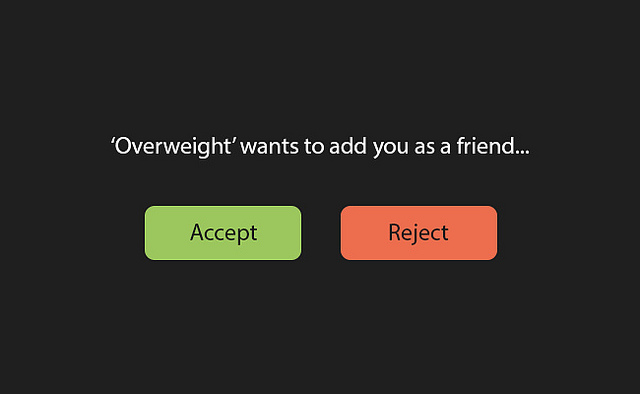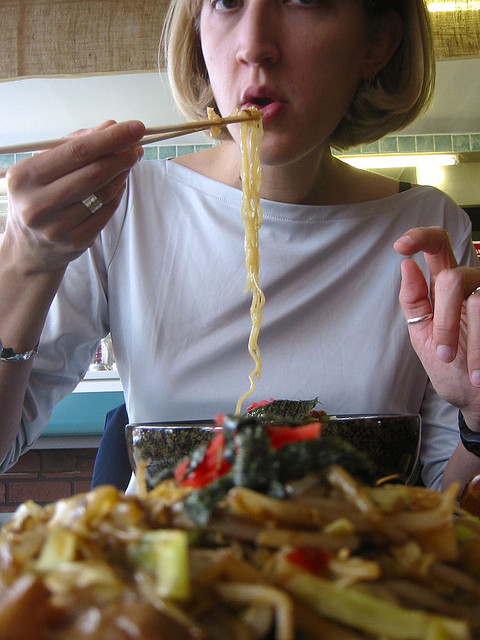
In response to The New York Times article, “Diet Advice That Ignores Hunger,” by Gary Taubes, Aug 29, 2015.
Imagine this.
You walk into a yoga class and the teacher says, “There’s only one way to do yoga poses and we are going to get it right! Yoga has strict rules, you must conform to those rules, and it has to be perfect. I won’t tolerate any transgression, slip, cheat or error! You are going to ignore your body, even if it screams in pain. You are going to deny all pain and keep cranking on that body until it looks just like mine! It’s possible you won’t be able to move tomorrow. That’s the price you pay to achieve! You may sustain a serious, irrevocable injury that affects you for the rest of your life, but that’s okay! You will look great for a tiny moment in time, and you’ll be able to say you did it! Yeah you!”
Who would stay?
It sounds ridiculous and, yet, that is exactly what millions of people are doing when they diet. If the diet industry was honest (excuse me while I burn a few calories laughing), they’d have a disclaimer on every book, bottle and box they sell:
To be used to aid temporary weight loss so you will feel depleted but look great at the wedding (family event, reunion, etc.). May cause subsequent rapid weight regain, diminished sense of self, and decreased metabolism for the remainder of life. Imagining you are broken has been reported in some instances.
Denying the body and its feeling of hunger is all part of the game of dieting. But diets go deeper, immersing us in diet mentality—a thinking pattern where deservedness is based on the off/on diet switch. Everything is black or white in this approach. We are either “good” or “bad.” We are on the diet or going to hell in a handbasket of bread (and starting over next Monday).
Diet mentality is pervasive in our culture, so prevalent it obscures a pertinent fact: Diets fail 95 to 99 percent of the time, varying very slightly on the research source.
And, if you don’t know that fact, it’s easy to take the failure personally. I know I did.
Dieting led me to severe depression, blood sugar issues, blackouts, vertigo and seizures. I fainted regularly on strict meal plans, liquid diets, fasts and bizarre food manipulations. I blitzed my metabolism, which made it increasingly harder to lose weight on every new diet I attempted.
I once woke up from a blackout to find myself licking the kitchen floor, presumably trying to resurrect my blood sugar to the point I could get back to my current fasting regime.
And the regain!
Regain is part of the game. With every weight regain, I felt more and more ashamed of my body. It appeared to have a will of its own and my sense of control careened wildly, from complete lockdown to all-out abandon with binges that still haunt me.
The pressure to throw health away on quick fix diets is tremendous. Media messages equating “thin = happy” and “ideal size = power” and “worth = appearance” are rampant.
In The New York Times article, “Diet Advice That Ignores Hunger,” author Gary Taubes discusses the long history of weight loss which has focused on restricting food and, by default, required human beings to deny their hunger.
Statistics show that approach has been a failure.
Throughout more than 20 years playing the diet-and-regain game, I slowly lost connection to my body, which I felt betrayed me over and over, and, without that connection, the very tools I needed to heal were missing.
Separating ourselves from hunger means not noticing when noticing is the key to change.
After losing 92 lbs, and sustaining the result since the year 2000, I believe hunger is the way to heal the madness.
Denying Hunger Encouraged by an Industry Hell-bent on Keeping Us Fat
Weight loss efforts which focus on denying hunger, come from outside us and are focused on quick results. We are genetically programmed with a poor ability to deny hunger very long (thus avoiding death, imagine that), and hence the result is temporary weight loss.
With every diet effort comes more intense hunger and the results last as long as that wedding we wanted to attend as a thin (read “normal”) person. The beautiful new dress fits perfectly while the couple repeats their vows, but, as quickly as the first hors d’oeuvre is tasted at the reception, the weight is galloping back toward empty fat cells in need of inflation.
The diet game is dominated and motivated by superficial appearance, just like the imaginary yoga teacher’s rant above: beat the body into submission now, worry about the debilitated metabolism and destroyed confidence later.
When I focused on the quick fix, I regained more weight than I lost each time, and regained faster with each effort. This is because the body gets better at making fat when it’s threatened. Dieting fatter is standard operating procedure. Many of my clients have dieted so often, and so strenuously, they can pack 25 lbs back onto maligned bodies in 30 days.
That’s little reward for months, sometimes years, of suffering and deprivation.
In an ideal world, a body would get better at weight loss, developing skill with every attempt, and offer some reward for the sacrifice of denying hunger.
In contrast to the temporary type, permanent weight loss is measured at the five-year marker, and very little weight loss sticks around to the two-year mark, according to the National Weight Control Registry, a joint research effort of Brown Medical School and the University of Colorado.
When I realized weight loss was one of the biggest industries ($60-70 billion a year, depending on the information source) that produces no tangible, lasting result, I got mad.
I’d been in their revolving door for over 20 years, which is precisely where they wanted me. I’d spent thousands of dollars. I’d sacrificed my body and created serious health problems. And the entire process felt like sandpaper on my soul too.
I was completely roughed up.
And I was pissed. Not your average anger or rage, this was a white, hot fury.
Along with the fury came a serving of pure humiliation.
I felt so exposed and vulnerable, no amount of excess fat could cover it up. Friends and family had witnessed my sacrifice, my weight loss, my many “wins,” and then averted their eyes as every pound, plus a few extra, hunted me down again.
My own confidence was shattered, but to experience people close to me feeling embarrassed for me was doubly bitter.
As my realization about the diet industry increased, I focused on the fury. Anger is a high vibration emotion, especially when you’ve been living in depression.
I’ll be honest. I don’t know what made me choose anger over one more retreat to shame. But, I decided struggling and sacrificing and suffering adding up to no result was not acceptable to me.

The Value of Hunger
As I began to assess my habits, I realized, rather than listening for a hunger cue, I had been eating by the clock, a practice first instituted during industrialization, when lunch breaks were programmed.
I was also ignoring hunger when I ate prophylactically, attempting to prevent future hunger out of fear it would lead to a binge.
Cultural pressure to eat, hungry or not, is also heavily influenced by the food industry. Snacking became popular in the 1970s, with the proliferation of processed and prepackaged snacks. Today, kids can’t attend a sports practice or after school class without a snack. The bottom line of many food manufacturers has benefited, but the personal waist and planet waste have only expanded.
Like many dieters, the hunger cue had been trained out of me. I had become a food grazer, moved by a mix of emotional and mental cues to eat randomly and often.
It was a prime focal point in my life.
I needed to control food, and indulge in everything, because the next diet would deprive me of taste, choice, satisfaction and freedom.
I wandered life looking for the tasty morsel to stuff into my mouth. It’s convenient and plentiful medication. My shame over eating grew to the point I felt terrible even after eating a healthy meal, and it depleted my confidence, necessitating even more food anesthesia.
While dieting intensified my fear of being hungry, it took me further and further from feeling hunger or satisfaction.
Reclaiming the Body
As I began my own personal reclaiming process, I discovered, slowly, haltingly, the body communicates—if you listen. It talks, riffs, sings, screams, gurgles, giggles, whispers…constantly.
I had to learn its language.
I wondered if the very cues I fought so valiantly while dieting, hunger and satiation, were actually there to help me. Maybe ignoring them meant I was ignoring legitimate needs.
Finding those cues after neglecting them for 20 years was an adventure fraught with confusion and frustration. I interpreted every physical buzz, hum and gurgle as hunger. Shockingly, I interpreted almost every discomfort as hunger. I threw away my effort daily in the beginning of my search.
But, after many failures, I found the cue tugging at my belly: a gnawing, gaping opening with a vibration unlike any other body feeling.
A space I’d lost.
Hunger.
True body hunger.
Descending into the utter beauty of hunger, I discovered increased taste receptors, positive and informative food cravings, a vibrant connection to my physical self, and the pure enjoyment of food.
Those cravings (if coming from the body, not the mind) were redefined as vital messages about nutritional needs.
Surprisingly, day to day, my body had vastly different needs. Why shouldn’t it? It’s only in the diet game where a flat calorie count is assumed for every day.
The body operates on a complicated set of mostly invisible internal processes and activity. I might not know when cellular repair was occurring, but I knew when I had a legitimate need for fuel. I could feel it.
Caloric need is also different every day to support the hormonal rock-and-roll most women experience. If there is one huge lesson I learned, it is women have been pushed into a linear, male-energy approach to diet and exercise and this approach is absolutely defeating.
For instance, the entire female body is preparing for internal upheaval during PMS; doesn’t it stand to reason a few (or many) extra calories might be necessary?
Next, I had to find another missing body cue—the satiation cue. This is a tiny, subtle indicator to stop eating.
Most children, if they haven’t been fed on a forced schedule, or encouraged to eat past their cues, still know their satiation point, but none of my coaching or healing clients have been able to readily identify that vital cue.
We’re well-trained to clean our plates, avoid wasting food (like waisting it is better?), and eat every bite purchased, regardless of body cues. In our society, getting more food for the same money, or, better yet, without charge at all, is seen as a bigger license to eat everything.
Locating my satiation cue required more determination and grit than locating the hunger cue. It took being completely conscious and attentive. I had to clear the mind out of the way and search.
At one point, I was convinced I simply didn’t have a cue. All evidence showed me I’d been braking or not braking at the table based on an idea in my head, or a diet measurement, but never a real cue.
I was also curious.
Finally, like a tiny glimmer in the darkness, there it was—the simplest wave of nausea—not surprisingly, a feeling I usually ate to obliterate because it was uncomfortable.
Stopping eating upon sensing the satiation cue was the toughest skill for me to master, and I’m still working on it. That’s because, quite often, the cue comes when there’s still plenty of food on the plate, especially in a restaurant, or life is distracting us in some way.
But I noticed, when respected, I felt energetic and alive in a new way. I felt free of impulse and at peace. I felt connected to my body in a way I’d never experienced. I instinctively knew I was feeling something true.
It’s the simplest freaking thing on earth, if the monkey mind, with its gift for sabotage, is removed from the equation.
I learned the body never complicates matters in its realm.
Here’s my theory, though it may seem obvious: when the body is not hungry, it has no place to put, or store, extra calories. The blood is full of blood sugar, muscles are full of glycogen and the energy needs of the major organs, glands and other physical systems are covered.
It really doesn’t matter if the boss brought donuts to a meeting, or Grandma sent a box of cookies, or Starbucks is offering a new 3,000-calorie drink in one of those cute cups.
Eating when you are not hungry is a clear message to the body: make and store fat.
Not eating when you are hungry is a clear message to the body: you are unimportant—die, for all I care.
Hunger v. Desire
No matter what you call eating from body cues—mindful, intuitive, or conscious eating—can be challenging in our over-busy world.
Eating for hunger means noticing the difference between real body hunger and desire labeled as hunger. The yearning pull of desire—for connection, soothing, attention, comfort, expression, meaning, sex, affection or anything at all—is often mislabeled as hunger.
Hunger is readily and openly accepted in our culture; most other needs are not.
Very few of us can show up at work and announce, “I so need a meaningful conversation with someone! Who has time to talk to me?”
I don’t know any mother who told her teenage daughter, “That deep emptiness in your belly might be hunger for food and it might be sexual desire—it’s a good idea to learn the difference.”
And how many of us ask for attention from partner, lover or spouse simply, without the drama usually manufactured for that hidden purpose? (My lover recently told me, “Come here, I need to look at you. I need to see you.” I didn’t need to eat for many hours after receiving his gentle attention.)
None of my weight loss clients has ever felt comfortable getting their deepest needs met. But food is easily attainable, usually within reach or requiring only a very small turn of the steering wheel on most busy roads.
Revering Body Intelligence
The Times’ article quotes an anonymous researcher as saying, “Asking people to eat less… is like asking them to breathe less. It sounds reasonable, so long as you don’t expect them to keep it up for long.”
Ignoring hunger cues only strengthens the ability to ignore other things, including the discomfort of excess weight. If we live mindfully, we are more likely to feel the first few pounds of excess weight, and adjustment would be safer, quicker, perhaps painless. Diets train us away from noticing.
My body was the only thing that could lead me to a healthy weight, and keep me there. But I had to hunt it down, reconnect to it, and learn to respect and apply its intelligence.
The body knows.
As I work closely with my clients to develop new relationships of trust and respect for their physical bodies, it gladdens my heart to see them find their natural healthiest weight, which may be thinner or heavier than they imagined.
Often, it was fighting their original, natural weight, because it didn’t look like Hollywood, or, truth be told, the slick yoga magazine ads, which sparked disordered eating in the first place.
Rather than working to create change from external information, substance, technology, or hunger denial, we focus on creating discernment, connection, respect, love, and, ultimately, peace—all of which live right inside our skin.
Listen.
It may be whispering. Or growling. Or screaming. But it is communicating.
Can you hear?
Relephant:
Dear Diet Industry: I’m Breaking up with You.
Bonus:
~
Author: Pat Barone
Editor: Catherine Monkman
Photos: Sean MacEntee/Flickr, Jeremy Keith/Flickr






Read 2 comments and reply